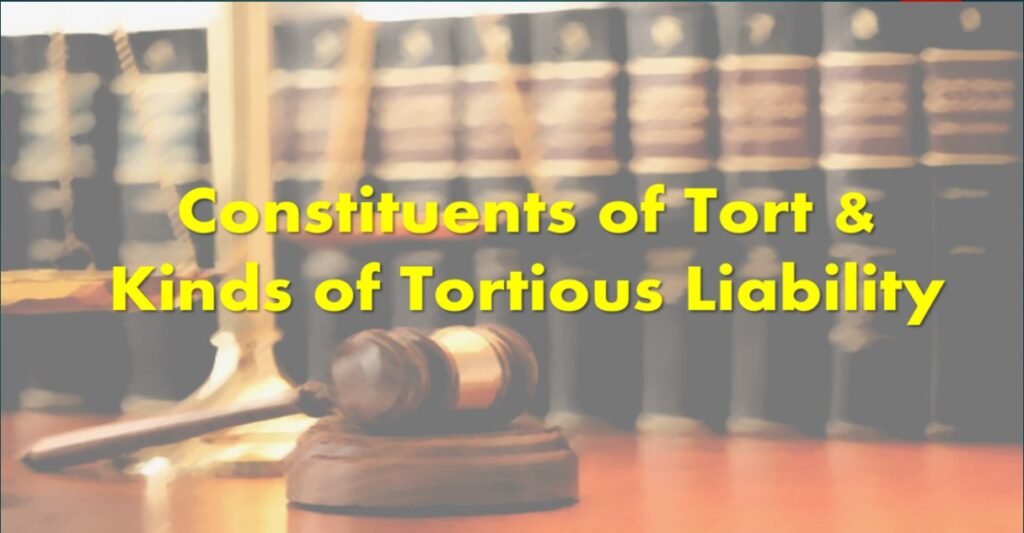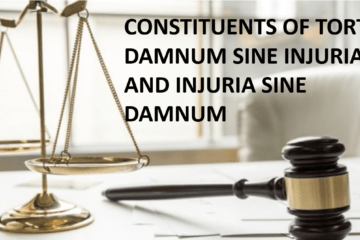
This Article is written by Vamakshi Pareek, 2nd Year, BA.LL.B., RNB Global University, Bikaner.
Injuria sine Damnum
The meaning of the maxim is Injury without damage. It means violation of a legal right but no harm caused. When there is an invasion of an “absolute” private right of an individual, there is an injuria and the plaintiff’s action will succeed even if there is no Damnum or damages. An absolute right is one, the violation of which is actionable per se, i.e., without the proof of any damage. Injuria sine damnum covers such cases where the right is violated even though no damage has occurred. Thus, the act of trespassing upon another’s land is actionable even though it has not caused the plaintiff even the slightest harm or damage.
The same thing was cited in the case of Ashby Vs. White, where the plaintiff, being a qualified voter, was stopped from casting the vote by the defendant, a returning officer. Though the cancellation did not affect the election and did no damage to the plaintiff but it was the breach of his legal right.
In another case of Bhim Singh Vs. State of J&K, where the plaintiff, MLA Bhim Singh, was wrongfully arrested and detained by the police and was also prevented from attending the session of the legislative assembly. As a voting session was going on in the session, his vote was significant. Even though the person to whom he wanted to vote for, eventually won, causing no damage to him, but his legal right to vote was infringed. Thus, he was entitled to reasonable compensation.
Marzetti Vs. Williams Bank was a case where the defendant bank refused to accept the cheque of the plaintiff even though he had sufficient fund in the account. It was held that such practices violated his legal right and he would be entitled to get compensation.
In the case of Asharfilal Vs. Municipal Corporation of Agra, the plaintiff, Asharfilal’s name was wrongfully deleted from the voters list by the concerned authorities, because of that the plaintiff could not caste his vote, which violated his fundamental right to vote. Thus, he was entitled to get compensation.
Damnum Sine Injuria
It means Damages without injury. It includes damages in which there is no infringement of the legal right. Since in cases where there is no infringement of legal right is involved, so no action lies. The basic principle of this maxim is that if a person exercises his ordinary rights without violating other’s legal right, but any damage is caused to that other person in the form of loss of money, comfort or health, etc., then no action of tort arises in such type of cases.
An example is the case of Gloucester Grammar School, where a person opened a rival school infront of the plaintiff’s school, which led to the fall in his profits. So, he sued the person, claiming compensation. But the court held that no remedy to the plaintiff for the loss suffered by him, because there was no infringement of legal right.
In another case of Day Vs. Browning, plaintiff’s house was known as Ashfrod Lodge for almost 60 years. Adjoining to it was defendant’s houses which was named as Ashfrod Villa for 40 years, but he renamed it same as that of plaintiff’s house name. So, the Plaintiff sued him and asked for compensation, while arguing that the act of defendant has caused inconvenience to him and had reduced the value of his property. The court held that no remedy would be available to him.
Kinds of Tortious Liability
There are three types of Tortious liability:
- Strict Liability
- Absolute Liability
- Vicarious Liability
Strict Liability
In some torts, the defendant is liable even though the harm to the plaintiff occurred without intention or negligence on the part of defendant. In other words, the defendant is held liable without fault.
Essentials: –
- Hazardous things- A person will be held strictly liable if he keeps any dangerous substance on his land and it escapes to other person’s land causing harm to him.
- Escape- Another essential is that there should be an escape of the hazardous substance from plaintiff’s to defendant’s premises. And if there is no escape takes place then plaintiff would not be held liable. For example: if the plaintiff’s horse intrudes into the defendant’s premises and eat a poisonous weed and dies, then defendant would not be held liable for the death as there was no escape from his land. (Ponting vs. Noakes).
- Non-Natural use of land- To constitute a strict liability, there should be a non-natural use of land which includes any activity which is dangerous to other people.
In landmark case of Rylands vs. Fletcher, the defendant constructed a water reservoir with the help of independent contractors. While digging the contractors ignored an open shaft and which led to the plaintiff’s coal mine. When the water was filled, it flooded the plaintiff’s mines, causing loss to him. Here, the defendant was held strictly liable for the negligence.
Exceptions to the rule of Strict Liability:
- Plaintiff’s fault- If the damage is caused to the plaintiff by his own fault then the defendant would not be held liable.
- Act of God- (Vis Major) An event which is beyond the control of human, that arises of natural causes and cannot be prevented even after taking due care and caution. If any loss occurs to the plaintiff because of natural cause, then the defendant would not be held liable.
- Act of third party- If any damage is caused to the plaintiff because of the act of any third party other than the defendant, then the defendant would not be held liable. For instance, in the case of Box Vs. Jubb, the reservoir of defendant overflowed because of the act of the third party, he emptied his drain through defendant’s reservoir. The court held that the defendant would not be held liable.
- Consent of the plaintiff- Also known as ‘volenti non fit injuria’. When the plaintiff suffers damage due to some act, for which he has given his own consent.
Hall Vs. Brookland (1932), where the plaintiff went to see a car race where two cars collided with each other and because of that he got injured as he was sitting in the front row. Here, the plaintiff gave his own consent, thus, the principle of volenti-non-fit-injuria was applied.
Absolute Liability
(Rule of Strict Liability-Exceptions)
This principle was evolved in the case of MC Mehta Vs. UOI, where the court observed that if any damage or loss occurs to the plaintiff because of the dangerous or hazardous activity of the defendant, even though he takes all proper precaution while carrying out that activity, the defendant will still be held absolutely liable.
Vicarious Liability
Normally, the tortfeasor is liable for his tort. But in some cases, a person may be held liable for the tort committed by another. A master is vicariously liable for the tort of his servant, principal for the tort of his agent and partners for the tort of a partner. This is known as vicarious liability in tort. But it is necessary that there should be some relation between those two people.
There are two maxims on the master-servant relationship:
- Qui facit per alium facit per se: Whenever a person gets the things done by another person, then such thing is viewed as he himself has done it. For instance, A is the master and he order his servant to take his car for a carwash. On the wat to the carwash, the car gets into an accident because of the servant’s rash driving. Here, even though A was nowhere involved in this but he would still be held liable for the accident.
- Respondant Superior: It is always assumed that the master is always at a superior financial condition than the servant, so he shall be liable for the acts of his subordinates.
- Difference between Servant and Independent Contractor
As we see, there is a slightest difference between a Servant and an independent contractor.
In case of a servant, there is a contract of service, where the master instructs the work to be done as well as the manner in which it has to be completed, to the servant.
Whereas in case of the independent contractor, there is a contract for service, where the master only instructs the work to be done but the manner in which it has to be done relies in the skills and will of the independent contractor.




0 Comments